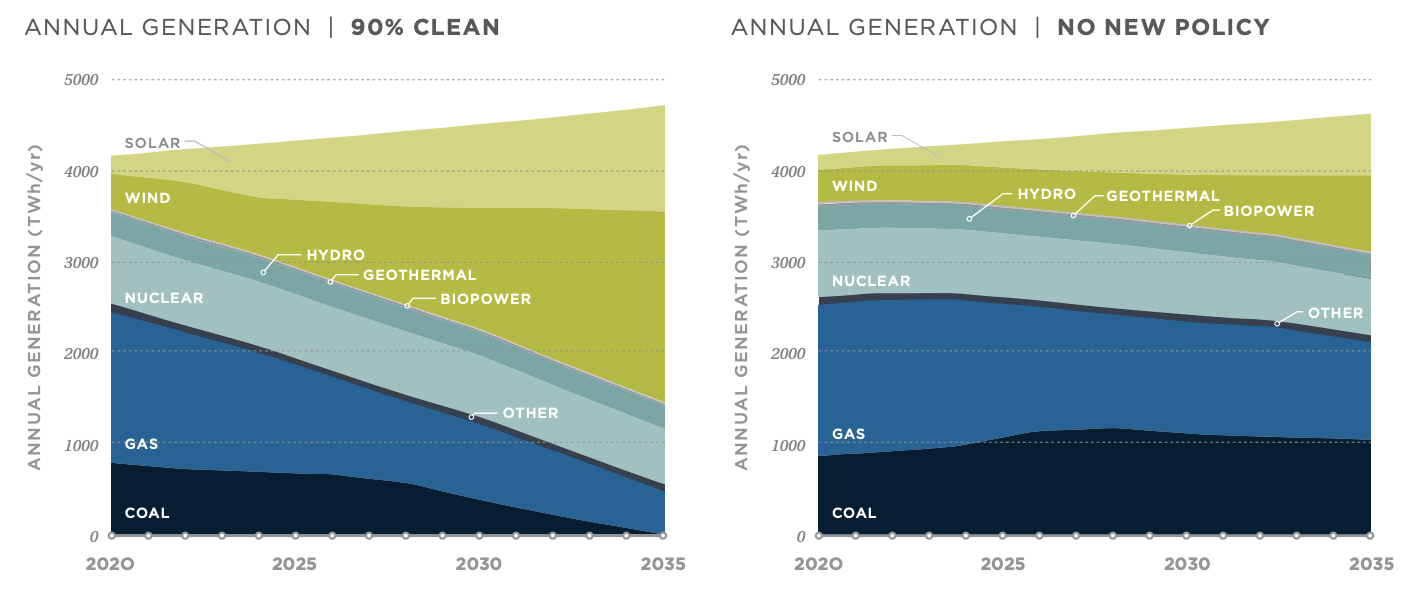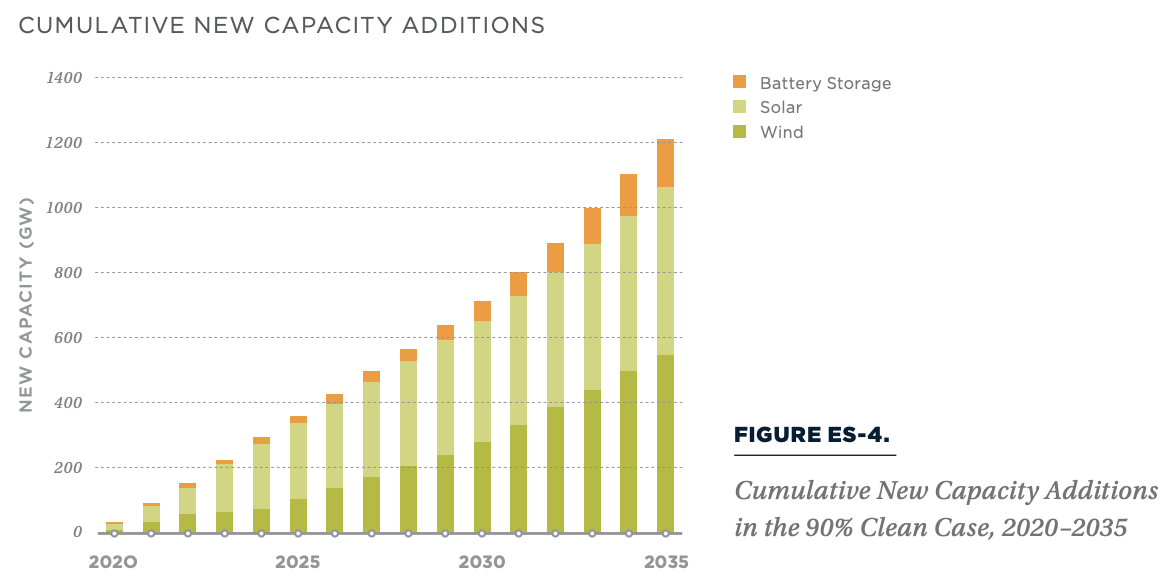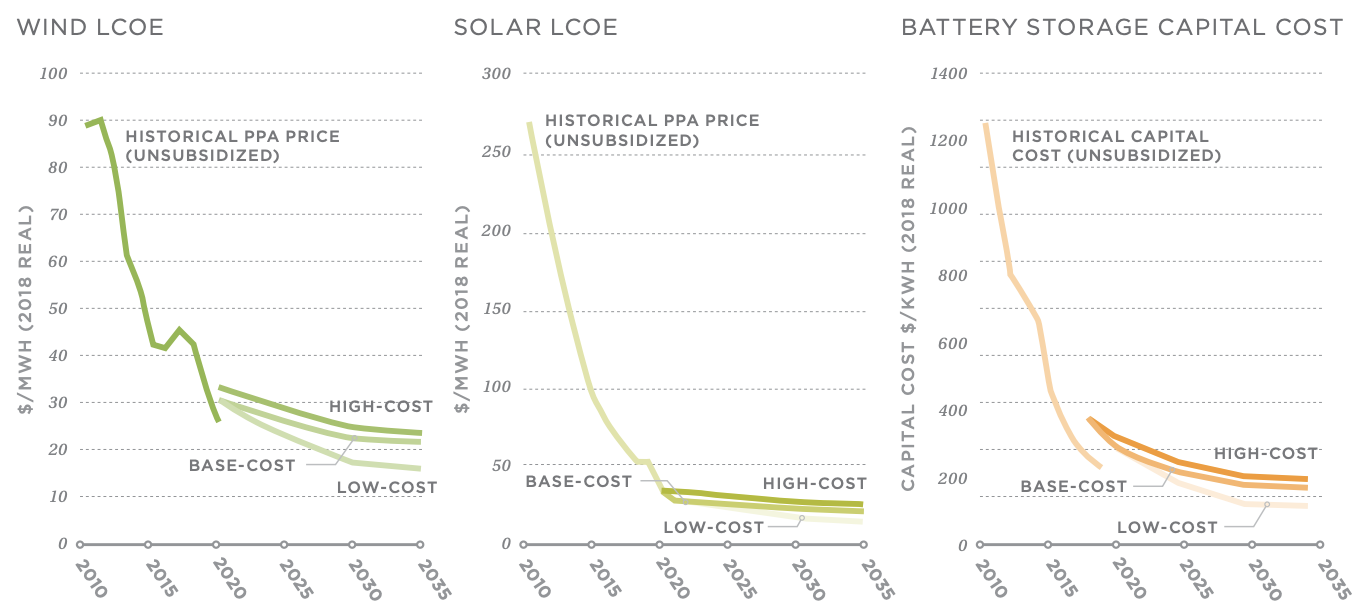President Joe Biden has promised that the U.S. electric sector will be carbon free by 2035. But, his plan for carbon neutrality is not realistic. A study by the University of California Berkeley, Goldman School of Public Policy, showed that achieving even a 90 percent carbon dioxide emissions-free grid by 2035 would mean about 70 percent of the nation’s power would need to be generated by solar and wind, requiring a combined increase of over 70 gigawatts each year for a total addition of 1,100 gigawatts of wind and solar power to be built by 2035. Such a massive construction program has not occurred in the United States on a continual basis. But, the study’s 90 percent carbon-free case assumes implementation of policies that would promote large-scale renewable energy adoption.
President Biden expects the United States to renew it manufacturing prowess with his “Build Back Better” program. However, the United States is not a major manufacturer of wind turbines or solar panels, requiring their import from China and Europe. Further, the manufacture of wind turbines and solar panels requires rare earth and other critical metals for which China dominates the supply chain and has cornered the market, meaning that China can change prices at will. Even a 90 percent carbon free grid by 2035 is not a pretty picture given the nation’s future energy dependence on China if Biden’s program of carbon neutrality gets implemented. The media seems incapable of asking any policy maker pushing Green New Deal-like policies questions about how becoming more dependent upon China for our essential energy supplies is a good thing.
The Study
The study was performed using 2 scenarios: one based on current policy, the No New Policy case, that achieves 55 percent non-carbon electricity in 2035 and a 90% Clean case that assumes strong policies drive the electricity system to attain a 90 percent non-carbon electricity generation by 2035. (See figure below.) The specific institutional, market, and regulatory changes needed to facilitate the rapid transformation are not identified in this study, but are found according to the authors in a companion report by Energy Innovation, which this blog does not address.
Generation Mix under 2 Scenarios, 2020-2035

Under the 90 percent carbon-free case, all existing coal plants are retired by 2035, and no new fossil fuel plants are built. Existing hydropower and nuclear capacity (after accounting for planned retirements) are retained and some of the existing natural gas capacity combined with new battery storage is used as back-up. During normal periods of generation and demand, the study authors indicate that wind, solar, and batteries provide 70 percent of annual generation, and hydropower and nuclear combine to provide 20 percent. During periods of very high demand and/or very low renewable generation, existing natural gas, hydropower, nuclear, and battery storage combine to fill the gap. Natural gas plants generate about 10 percent of total annual electricity generation—about 70 percent lower than their generation in 2019. According to the authors, using existing natural gas capacity to meet about 10 percent of electricity demand avoids the need to build excess renewable energy and long-duration storage capacity. A large construction program in wind and solar units, however, is needed to achieve 90 percent carbon-free electricity by 2035.
The study expects 1,100 gigawatts of new wind and solar capacity to be built, averaging over 70 gigawatts annually. (See figure below.) Note that this level of solar and wind capacity builds has not occurred in the past despite state mandates and significant federal and state subsidies, which is the reason that significant policy initiatives would be needed to attract this level of construction. The annual manufacturing capacity of the domestic solar panel industry last year was just 9 gigawatts, compared to 130 gigawatts in China. The top solar panel manufacturers are in China, representing about 70 percent of the solar manufacturing industry. The largest manufacturers of wind turbines are also not domestic with Danish wind turbine manufacturer Vestas currently the world’s largest wind turbine maker, representing over 16 percent of the world wind turbine market, followed by Spanish Siemens Gamesa and China’s Goldwind. Further, the United States is dependent on rare earth and critical elements that China currently controls, which are needed for wind and solar technology production.

Methodology
In the study’s 90 percent carbon-free case, the study authors require the electricity share to be 90 percent carbon-free by 2035. The authors assumed hydropower, nuclear, wind, PV, and biomass produce no direct carbon dioxide emissions. In their No New Policy case, the technology mix is determined by least-cost capacity-expansion modeling. The Energy Information Administration’s (EIA) Annual Energy Outlook 2020 Reference Case expects electric generation to be 47 percent carbon-free by 2035—8 percentage points less than the No New Policy Case in this study. That means it is easier for this study to attain a carbon-free electric sector than the EIA 2020 reference case would predict.
The study uses the EIA’s natural gas prices and the National Renewable Energy Laboratory’s renewable energy and battery cost projections. The study authors perform sensitivity analysis on these assumptions but do not detail the results in the main report.

Because solar generation drops to zero during nighttime hours and wind generation can drop to a meager 5 or 10 percent capacity factor, the study authors use battery energy storage as a viable option for cost-effectively integrating high levels of wind and solar generation into electricity grids. They estimate that about 600-gigawatt hours (150 gigawatts for 4 hours) of storage would be needed in the 90 percent carbon-free case, representing about 20 percent of daily electricity demand. When renewable energy generation exceeds demand, storage batteries are charged and they dispatch electricity when renewable generation falls short of demand. Despite the addition of storage, about 14 percent of available renewable energy is curtailed annually in the study forecast.
Under the 90 percent carbon free case, the study finds most transmission investments are in new spur line transmission rather than bulk transmission. Although the 90 percent carbon free case requires about three times more spur line investment than the No New Policy case, the study finds the total transmission requirements in the 90 percent carbon free case to add only 0.2 cents per kilowatt hour to total system costs. The report notes that further work is needed to understand transmission needs more precisely.
Wholesale electricity (generation plus incremental transmission) cost under the 90 percent carbon free case in 2035 is 4.6 cents per kilowatt hour—0.46 cents per kilowatt hour (12 percent) higher than they are under the No New Policy case in 2035. Higher costs are expected due to the massive construction program being undertaken, which is not needed when perfectly good fossil fuel generating capacity that does not need to be retired is available to electricity consumers. Those technologies are just not politically correct under a Biden Administration.
Conclusion
Biden wants a carbon free generating sector by 2035. The study by Berkeley University examines a 90 percent carbon free case by 2035 that results in higher costs for consumers than using currently available technologies. It requires that 1,100 gigawatts of solar and wind capacity be built by 2035—over 70 gigawatts each year—and that all coal plants and most natural gas plants in the United States be prematurely retired. This new construction of capacity is equal to the entire existing U.S. generation system. Unfortunately, the United States is not a mecca for wind and solar or battery manufacturing, which means that the United States will need to import technology from China and Europe, making the United States dependent on a communist country for its solar panels and rare earth and critical metals needed in the production of wind turbines and solar panels. Instead of using American energy which has made the United States independent for the first time since 1957, the U.S. policies being pursued will result in jettisoning that long-sought after success and becoming rapidly more dependent upon China for our energy.



